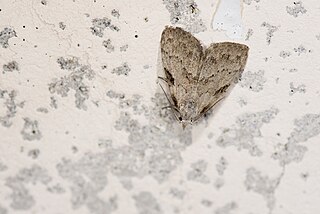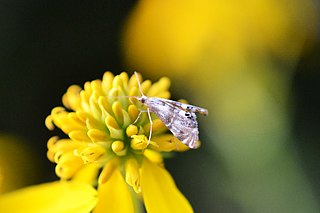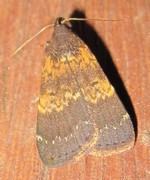
The Lymantriinae are a subfamily of moths of the family Erebidae. The taxon was erected by George Hampson in 1893.

Pyraustinae is a large subfamily of the lepidopteran family Crambidae, the crambid snout moths. It currently includes over 1,400 species; most of them tropical but some found in temperate regions including both North America and Europe.

Acontiinae is a subfamily of bird dropping moths in the family Noctuidae. There are more than 50 genera and 430 described species in Acontiinae, found worldwide in temperate and tropical climates.

Hypena is a genus of moths in the family Erebidae. It was first described by Franz von Paula Schrank in 1802. These non-migratory moths overwinter as pupae and almost never estivate as adults.

Ceryx is a genus of moths in the family Erebidae. It was described by Hans Daniel Johan Wallengren in 1863.

Manoba is a genus of moths in the family Nolidae. The genus was first described by Francis Walker in 1863.
Oenobotys is a genus of moths of the family Crambidae.

Petrophila is a genus of moths of the family Crambidae. The genus was described by Lansdown Guilding in 1830.
Bendisodes is a monotypic moth genus in the family Erebidae erected by George Hampson in 1924. Its only species, Bendisodes aeolia, was described by Druce in 1890. It is found in North America.

Drasteria is a genus of moths in the family Erebidae.

Hydrillodes is a genus of litter moths of the family Erebidae first described by Achille Guenée in 1854. Its validity is somewhat disputed.
Stenhypena is a genus of moths of the family Erebidae erected by George Hampson in 1895. The type species was first found in Sri Lanka.

Bityla sericea is a species of moth in the family Noctuidae. This species is endemic to New Zealand. It is classified as "At Risk, Naturally Uncommon" by the New Zealand Department of Conservation.

Simplicia cornicalis is a litter moth of the family Erebidae. The species was first described by Johan Christian Fabricius in 1794. It is found in south-eastern Asia and the Pacific. Records include New Caledonia, Réunion, Thailand, Fiji, Hawaii, India, Sri Lanka, the Society Islands, as well as New South Wales and Queensland in Australia. It is an introduced species in southern Florida and Louisiana in the United States.
Scopula aspilataria is a moth of the family Geometridae. It was described by Francis Walker in 1861. It is found in Sri Lanka.

Banisia myrsusalis, the sapodilla borer or sapota midrib folder, is a species of moth of the family Thyrididae. It was described by Francis Walker in 1859 and is found in North America, Brazil, Australia, southern Asia and Africa.
Oenobotys texanalis is a moth in the family Crambidae. It was described by Eugene G. Munroe, E. Blanchard and A. Blanchard in 1976. It is found in North America, where it has been recorded from Texas.

Ostrinia penitalis, the American lotus borer, is a moth in the family Crambidae. It was described by Augustus Radcliffe Grote in 1876. It is found from Mexico, through Central America to Amazonas, Brazil. It is also found in North America, where it has been recorded from Quebec to British Columbia and most of the United States. The habitat consists of marshes and pondsides.
Plutodes exiguifascia is a moth of the family Geometridae first described by George Hampson in 1895. It is found in Sri Lanka.

Rivula basalis is a moth of the family Erebidae first described by George Hampson in 1891. It is found in South India, Sri Lanka, Indo-China, Thailand, South China, Taiwan, Java, Bali and Borneo.














